MGMT1101: Leadership Management Profile - Theory to Application
VerifiedAdded on 2023/04/20
|11
|2444
|404
Report
AI Summary
This report presents a leadership management profile that analyzes and applies various leadership approaches, connecting theory to practical application. It begins with an exploration of the trait theory, identifying personal strengths such as self-confidence, honesty, and emotional maturity. The report then discusses situational, transformational, and servant leadership styles, advocating for the effectiveness of transformational leadership in enhancing employee engagement. The leadership characteristics of Adolf Hitler and Osama are analyzed, followed by an examination of different leadership scenarios and the application of appropriate leadership styles, including Telling, Supportive, Directive, and Participating. The report concludes with a personal leadership profile, outlining the author's participative leadership style, mission and vision statements, core values, and a reflection on the transformational leadership theory. The analysis emphasizes the importance of motivation, situational analysis skills, emotional intelligence, and dedication in becoming an effective leader. Desklib provides access to similar solved assignments and past papers for students.
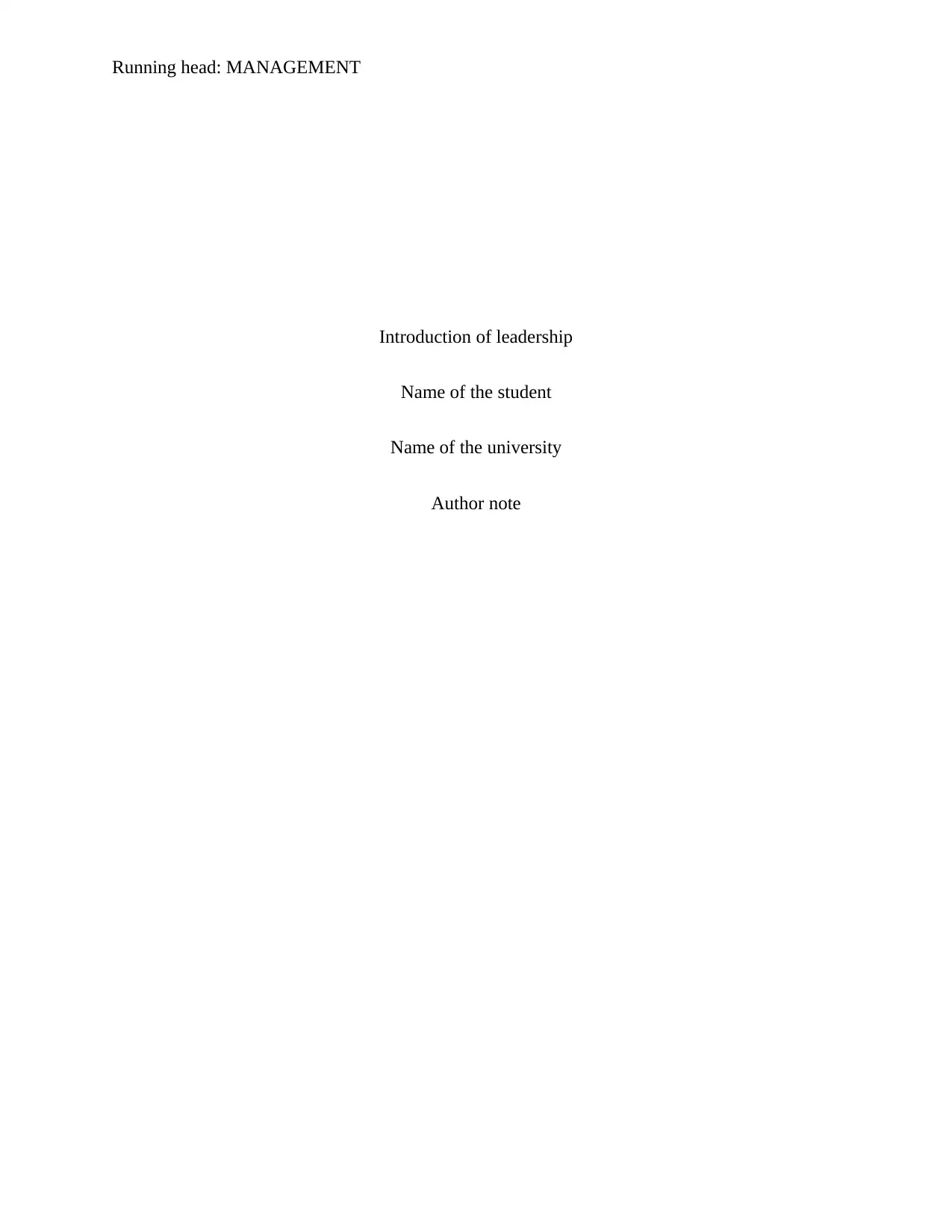
Running head: MANAGEMENT
Introduction of leadership
Name of the student
Name of the university
Author note
Introduction of leadership
Name of the student
Name of the university
Author note
Paraphrase This Document
Need a fresh take? Get an instant paraphrase of this document with our AI Paraphraser
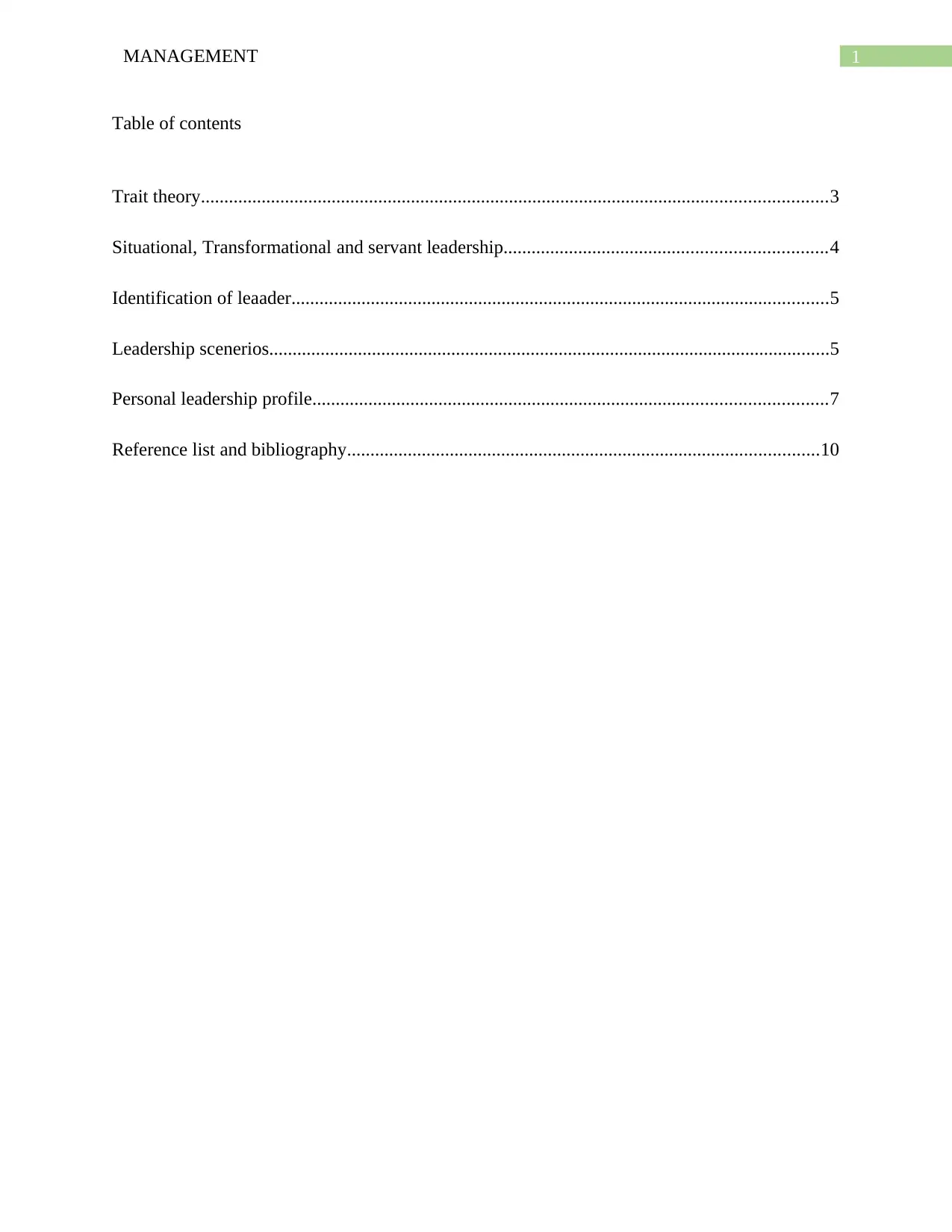
1MANAGEMENT
Table of contents
Trait theory......................................................................................................................................3
Situational, Transformational and servant leadership.....................................................................4
Identification of leaader...................................................................................................................5
Leadership scenerios........................................................................................................................5
Personal leadership profile..............................................................................................................7
Reference list and bibliography.....................................................................................................10
Table of contents
Trait theory......................................................................................................................................3
Situational, Transformational and servant leadership.....................................................................4
Identification of leaader...................................................................................................................5
Leadership scenerios........................................................................................................................5
Personal leadership profile..............................................................................................................7
Reference list and bibliography.....................................................................................................10

2MANAGEMENT
Trait theory
The trait model of leadership is being developed depending on the behavioral
characteristics of individuals (Prentice, Jayawickreme & Fleeson, 2018). In the trait leadership
model both the positive and negative characteristics of the leaders are being reflected. Analyzing
my characteristics, I have identified that strong self-confidence, honesty and emotional
maturity are the three traits of mine. I always try to provide the honest feedbacks to others and I
also love to get back the same from others. Few days back in a corporate meeting, where
individuals were asked for commenting on the management decision. In the session, everyone
have supported the decision of the management for avoiding the debate, rather than supporting
the wrong decision, I gave my honest feedback against the decision. During my class, I have
asked to make a presentation on an unfamiliar topic. Rather than being afraid I handled the entire
presentation in proper manner, which had impressed the audience. I believe, my situational
handling ability makes me confident towards fulfilling my responsibilities. Using my emotional
intelligence skills, I can easily get connected with others.
I believe the situational analysis ability of mine is another important personality trait that
can also be beneficial for becoming a good leader. This quality of mine helps me to blend myself
in different situation, which increase my challenge accepting ability. I believe, using this
leadership skill, it will be easier for me to develop strong image on the mind of my coworkers
and convince them towards contributing in handing the situation.
In the self-assessment, it has been analyzed by me that the behavioral traits which can
help me to become an effective leader. As per my understanding, emotional situation of mine can
help me using my emotional intelligence skills, I can maturely handle the difficult situations. An
Trait theory
The trait model of leadership is being developed depending on the behavioral
characteristics of individuals (Prentice, Jayawickreme & Fleeson, 2018). In the trait leadership
model both the positive and negative characteristics of the leaders are being reflected. Analyzing
my characteristics, I have identified that strong self-confidence, honesty and emotional
maturity are the three traits of mine. I always try to provide the honest feedbacks to others and I
also love to get back the same from others. Few days back in a corporate meeting, where
individuals were asked for commenting on the management decision. In the session, everyone
have supported the decision of the management for avoiding the debate, rather than supporting
the wrong decision, I gave my honest feedback against the decision. During my class, I have
asked to make a presentation on an unfamiliar topic. Rather than being afraid I handled the entire
presentation in proper manner, which had impressed the audience. I believe, my situational
handling ability makes me confident towards fulfilling my responsibilities. Using my emotional
intelligence skills, I can easily get connected with others.
I believe the situational analysis ability of mine is another important personality trait that
can also be beneficial for becoming a good leader. This quality of mine helps me to blend myself
in different situation, which increase my challenge accepting ability. I believe, using this
leadership skill, it will be easier for me to develop strong image on the mind of my coworkers
and convince them towards contributing in handing the situation.
In the self-assessment, it has been analyzed by me that the behavioral traits which can
help me to become an effective leader. As per my understanding, emotional situation of mine can
help me using my emotional intelligence skills, I can maturely handle the difficult situations. An
⊘ This is a preview!⊘
Do you want full access?
Subscribe today to unlock all pages.

Trusted by 1+ million students worldwide
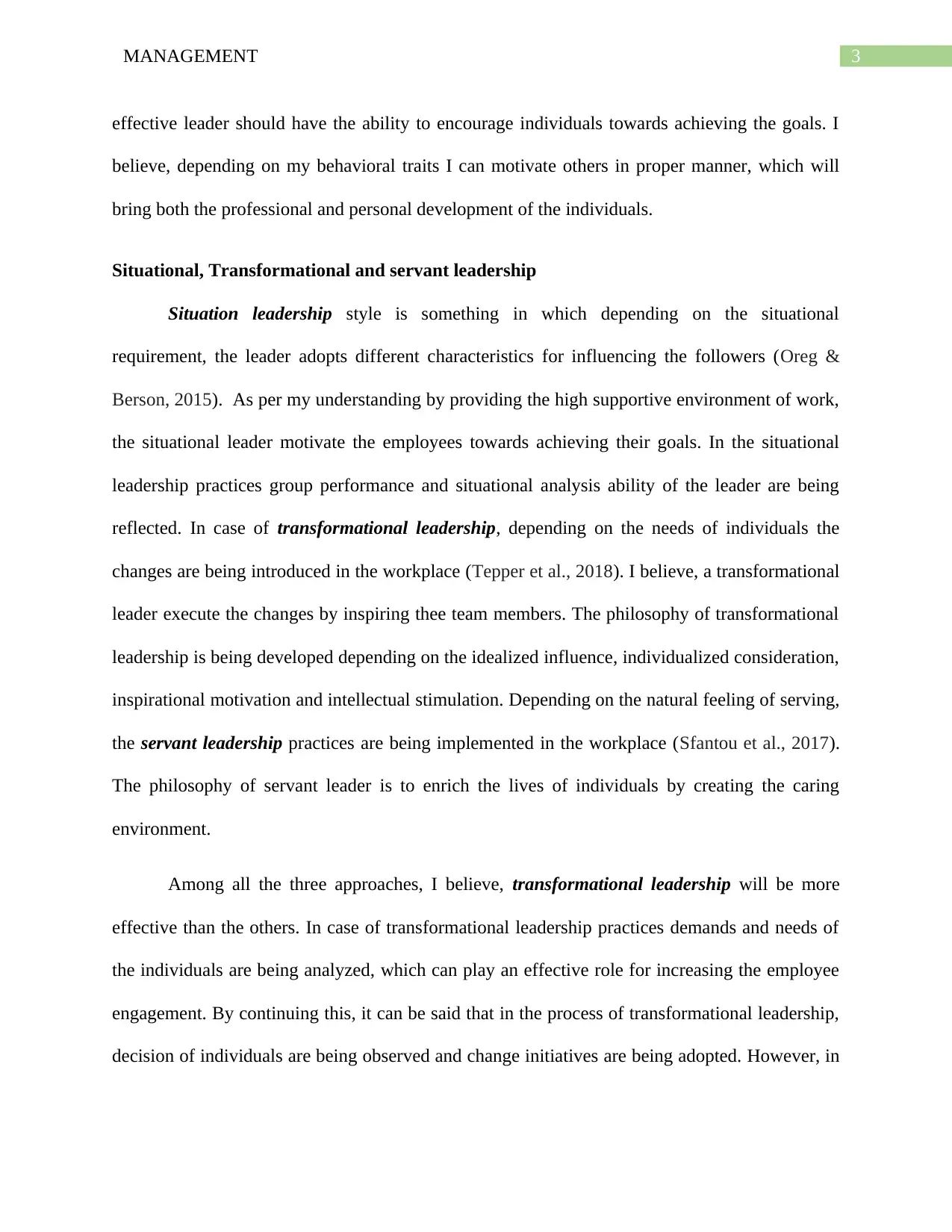
3MANAGEMENT
effective leader should have the ability to encourage individuals towards achieving the goals. I
believe, depending on my behavioral traits I can motivate others in proper manner, which will
bring both the professional and personal development of the individuals.
Situational, Transformational and servant leadership
Situation leadership style is something in which depending on the situational
requirement, the leader adopts different characteristics for influencing the followers (Oreg &
Berson, 2015). As per my understanding by providing the high supportive environment of work,
the situational leader motivate the employees towards achieving their goals. In the situational
leadership practices group performance and situational analysis ability of the leader are being
reflected. In case of transformational leadership, depending on the needs of individuals the
changes are being introduced in the workplace (Tepper et al., 2018). I believe, a transformational
leader execute the changes by inspiring thee team members. The philosophy of transformational
leadership is being developed depending on the idealized influence, individualized consideration,
inspirational motivation and intellectual stimulation. Depending on the natural feeling of serving,
the servant leadership practices are being implemented in the workplace (Sfantou et al., 2017).
The philosophy of servant leader is to enrich the lives of individuals by creating the caring
environment.
Among all the three approaches, I believe, transformational leadership will be more
effective than the others. In case of transformational leadership practices demands and needs of
the individuals are being analyzed, which can play an effective role for increasing the employee
engagement. By continuing this, it can be said that in the process of transformational leadership,
decision of individuals are being observed and change initiatives are being adopted. However, in
effective leader should have the ability to encourage individuals towards achieving the goals. I
believe, depending on my behavioral traits I can motivate others in proper manner, which will
bring both the professional and personal development of the individuals.
Situational, Transformational and servant leadership
Situation leadership style is something in which depending on the situational
requirement, the leader adopts different characteristics for influencing the followers (Oreg &
Berson, 2015). As per my understanding by providing the high supportive environment of work,
the situational leader motivate the employees towards achieving their goals. In the situational
leadership practices group performance and situational analysis ability of the leader are being
reflected. In case of transformational leadership, depending on the needs of individuals the
changes are being introduced in the workplace (Tepper et al., 2018). I believe, a transformational
leader execute the changes by inspiring thee team members. The philosophy of transformational
leadership is being developed depending on the idealized influence, individualized consideration,
inspirational motivation and intellectual stimulation. Depending on the natural feeling of serving,
the servant leadership practices are being implemented in the workplace (Sfantou et al., 2017).
The philosophy of servant leader is to enrich the lives of individuals by creating the caring
environment.
Among all the three approaches, I believe, transformational leadership will be more
effective than the others. In case of transformational leadership practices demands and needs of
the individuals are being analyzed, which can play an effective role for increasing the employee
engagement. By continuing this, it can be said that in the process of transformational leadership,
decision of individuals are being observed and change initiatives are being adopted. However, in
Paraphrase This Document
Need a fresh take? Get an instant paraphrase of this document with our AI Paraphraser
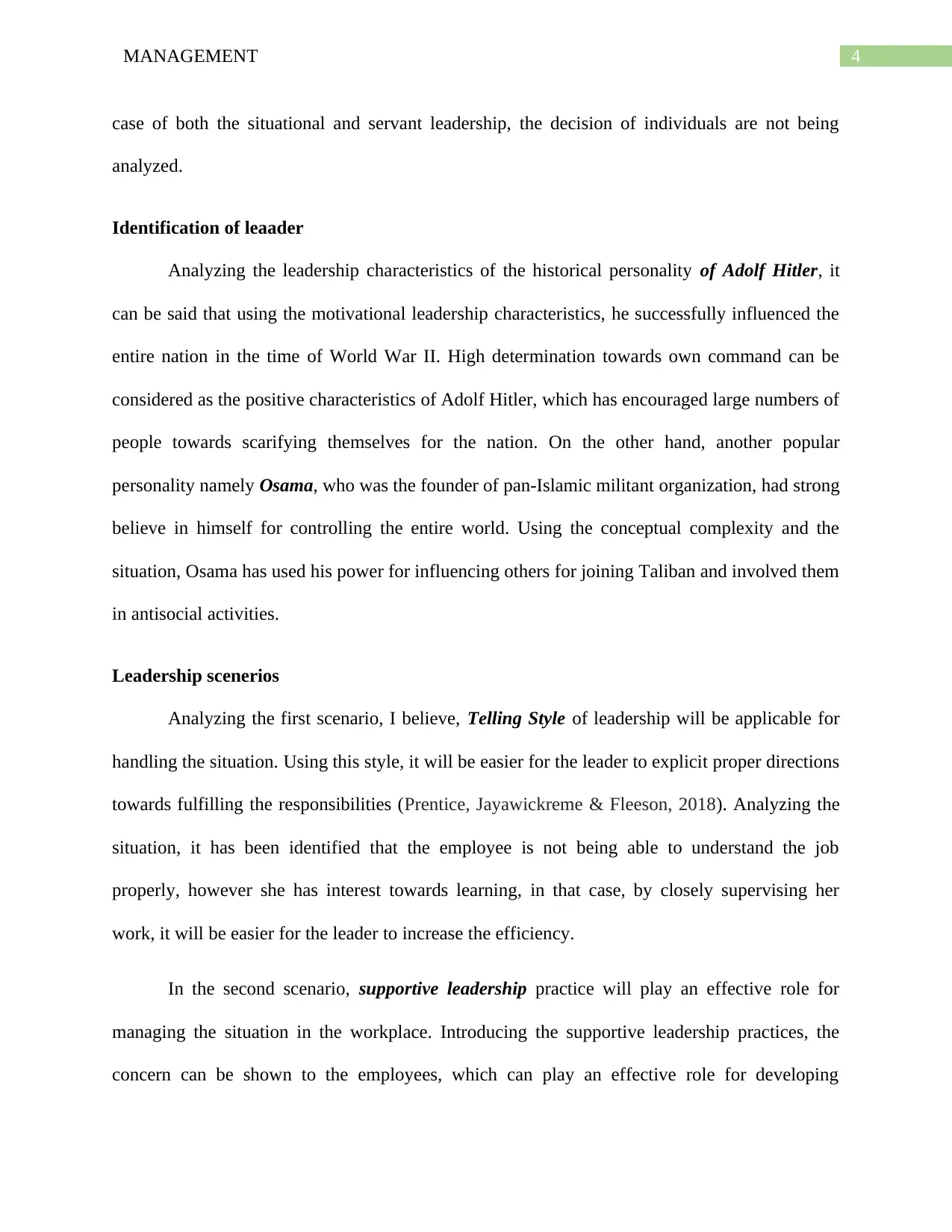
4MANAGEMENT
case of both the situational and servant leadership, the decision of individuals are not being
analyzed.
Identification of leaader
Analyzing the leadership characteristics of the historical personality of Adolf Hitler, it
can be said that using the motivational leadership characteristics, he successfully influenced the
entire nation in the time of World War II. High determination towards own command can be
considered as the positive characteristics of Adolf Hitler, which has encouraged large numbers of
people towards scarifying themselves for the nation. On the other hand, another popular
personality namely Osama, who was the founder of pan-Islamic militant organization, had strong
believe in himself for controlling the entire world. Using the conceptual complexity and the
situation, Osama has used his power for influencing others for joining Taliban and involved them
in antisocial activities.
Leadership scenerios
Analyzing the first scenario, I believe, Telling Style of leadership will be applicable for
handling the situation. Using this style, it will be easier for the leader to explicit proper directions
towards fulfilling the responsibilities (Prentice, Jayawickreme & Fleeson, 2018). Analyzing the
situation, it has been identified that the employee is not being able to understand the job
properly, however she has interest towards learning, in that case, by closely supervising her
work, it will be easier for the leader to increase the efficiency.
In the second scenario, supportive leadership practice will play an effective role for
managing the situation in the workplace. Introducing the supportive leadership practices, the
concern can be shown to the employees, which can play an effective role for developing
case of both the situational and servant leadership, the decision of individuals are not being
analyzed.
Identification of leaader
Analyzing the leadership characteristics of the historical personality of Adolf Hitler, it
can be said that using the motivational leadership characteristics, he successfully influenced the
entire nation in the time of World War II. High determination towards own command can be
considered as the positive characteristics of Adolf Hitler, which has encouraged large numbers of
people towards scarifying themselves for the nation. On the other hand, another popular
personality namely Osama, who was the founder of pan-Islamic militant organization, had strong
believe in himself for controlling the entire world. Using the conceptual complexity and the
situation, Osama has used his power for influencing others for joining Taliban and involved them
in antisocial activities.
Leadership scenerios
Analyzing the first scenario, I believe, Telling Style of leadership will be applicable for
handling the situation. Using this style, it will be easier for the leader to explicit proper directions
towards fulfilling the responsibilities (Prentice, Jayawickreme & Fleeson, 2018). Analyzing the
situation, it has been identified that the employee is not being able to understand the job
properly, however she has interest towards learning, in that case, by closely supervising her
work, it will be easier for the leader to increase the efficiency.
In the second scenario, supportive leadership practice will play an effective role for
managing the situation in the workplace. Introducing the supportive leadership practices, the
concern can be shown to the employees, which can play an effective role for developing
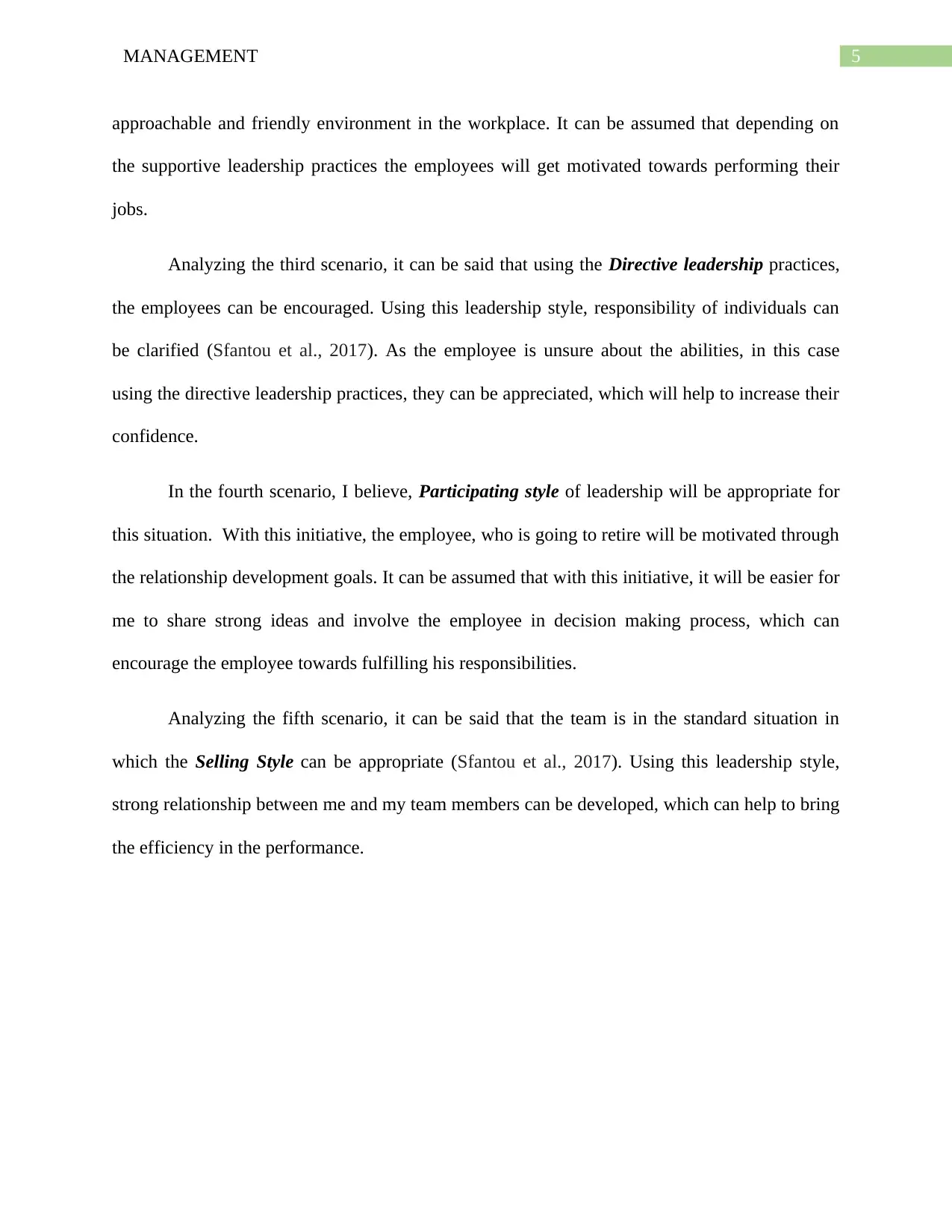
5MANAGEMENT
approachable and friendly environment in the workplace. It can be assumed that depending on
the supportive leadership practices the employees will get motivated towards performing their
jobs.
Analyzing the third scenario, it can be said that using the Directive leadership practices,
the employees can be encouraged. Using this leadership style, responsibility of individuals can
be clarified (Sfantou et al., 2017). As the employee is unsure about the abilities, in this case
using the directive leadership practices, they can be appreciated, which will help to increase their
confidence.
In the fourth scenario, I believe, Participating style of leadership will be appropriate for
this situation. With this initiative, the employee, who is going to retire will be motivated through
the relationship development goals. It can be assumed that with this initiative, it will be easier for
me to share strong ideas and involve the employee in decision making process, which can
encourage the employee towards fulfilling his responsibilities.
Analyzing the fifth scenario, it can be said that the team is in the standard situation in
which the Selling Style can be appropriate (Sfantou et al., 2017). Using this leadership style,
strong relationship between me and my team members can be developed, which can help to bring
the efficiency in the performance.
approachable and friendly environment in the workplace. It can be assumed that depending on
the supportive leadership practices the employees will get motivated towards performing their
jobs.
Analyzing the third scenario, it can be said that using the Directive leadership practices,
the employees can be encouraged. Using this leadership style, responsibility of individuals can
be clarified (Sfantou et al., 2017). As the employee is unsure about the abilities, in this case
using the directive leadership practices, they can be appreciated, which will help to increase their
confidence.
In the fourth scenario, I believe, Participating style of leadership will be appropriate for
this situation. With this initiative, the employee, who is going to retire will be motivated through
the relationship development goals. It can be assumed that with this initiative, it will be easier for
me to share strong ideas and involve the employee in decision making process, which can
encourage the employee towards fulfilling his responsibilities.
Analyzing the fifth scenario, it can be said that the team is in the standard situation in
which the Selling Style can be appropriate (Sfantou et al., 2017). Using this leadership style,
strong relationship between me and my team members can be developed, which can help to bring
the efficiency in the performance.
⊘ This is a preview!⊘
Do you want full access?
Subscribe today to unlock all pages.

Trusted by 1+ million students worldwide
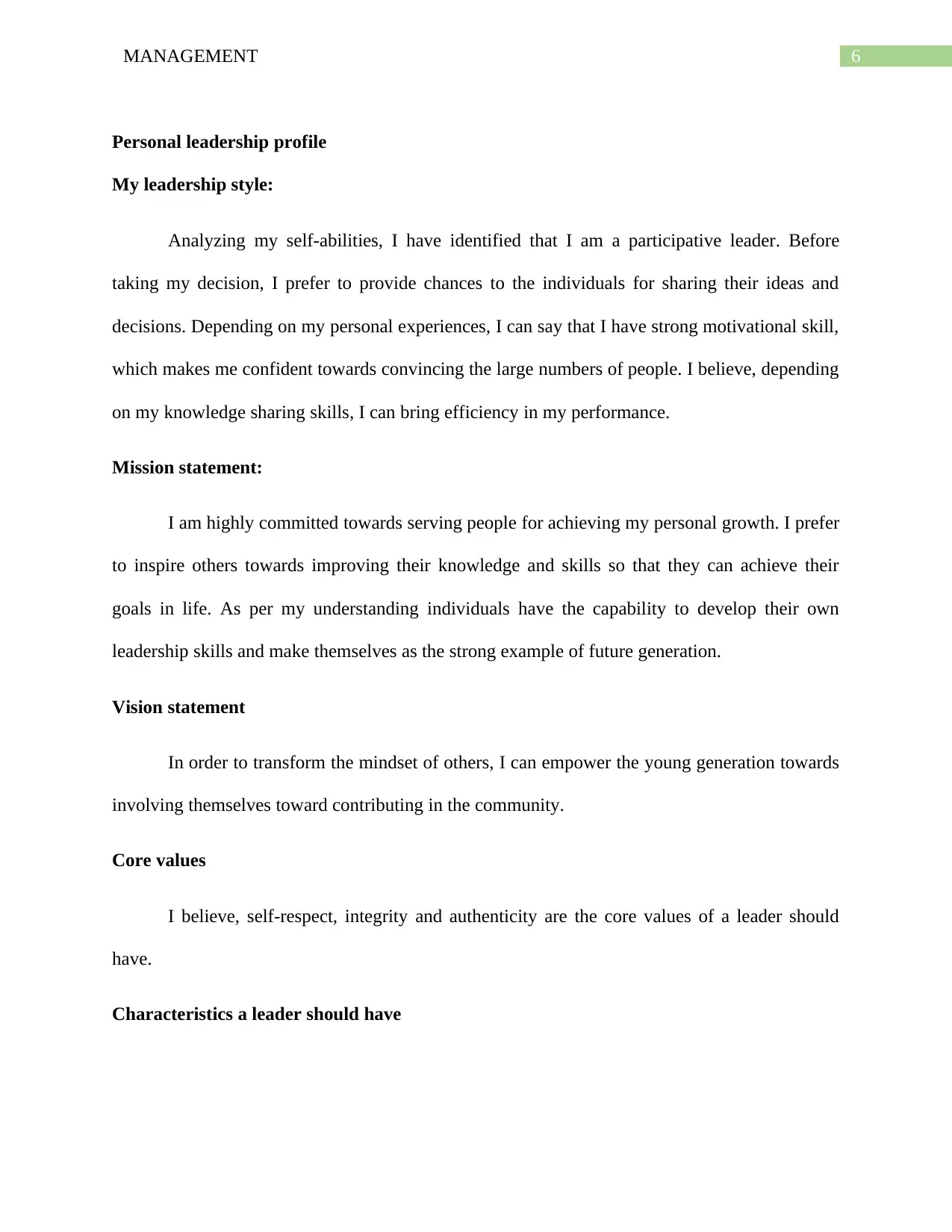
6MANAGEMENT
Personal leadership profile
My leadership style:
Analyzing my self-abilities, I have identified that I am a participative leader. Before
taking my decision, I prefer to provide chances to the individuals for sharing their ideas and
decisions. Depending on my personal experiences, I can say that I have strong motivational skill,
which makes me confident towards convincing the large numbers of people. I believe, depending
on my knowledge sharing skills, I can bring efficiency in my performance.
Mission statement:
I am highly committed towards serving people for achieving my personal growth. I prefer
to inspire others towards improving their knowledge and skills so that they can achieve their
goals in life. As per my understanding individuals have the capability to develop their own
leadership skills and make themselves as the strong example of future generation.
Vision statement
In order to transform the mindset of others, I can empower the young generation towards
involving themselves toward contributing in the community.
Core values
I believe, self-respect, integrity and authenticity are the core values of a leader should
have.
Characteristics a leader should have
Personal leadership profile
My leadership style:
Analyzing my self-abilities, I have identified that I am a participative leader. Before
taking my decision, I prefer to provide chances to the individuals for sharing their ideas and
decisions. Depending on my personal experiences, I can say that I have strong motivational skill,
which makes me confident towards convincing the large numbers of people. I believe, depending
on my knowledge sharing skills, I can bring efficiency in my performance.
Mission statement:
I am highly committed towards serving people for achieving my personal growth. I prefer
to inspire others towards improving their knowledge and skills so that they can achieve their
goals in life. As per my understanding individuals have the capability to develop their own
leadership skills and make themselves as the strong example of future generation.
Vision statement
In order to transform the mindset of others, I can empower the young generation towards
involving themselves toward contributing in the community.
Core values
I believe, self-respect, integrity and authenticity are the core values of a leader should
have.
Characteristics a leader should have
Paraphrase This Document
Need a fresh take? Get an instant paraphrase of this document with our AI Paraphraser
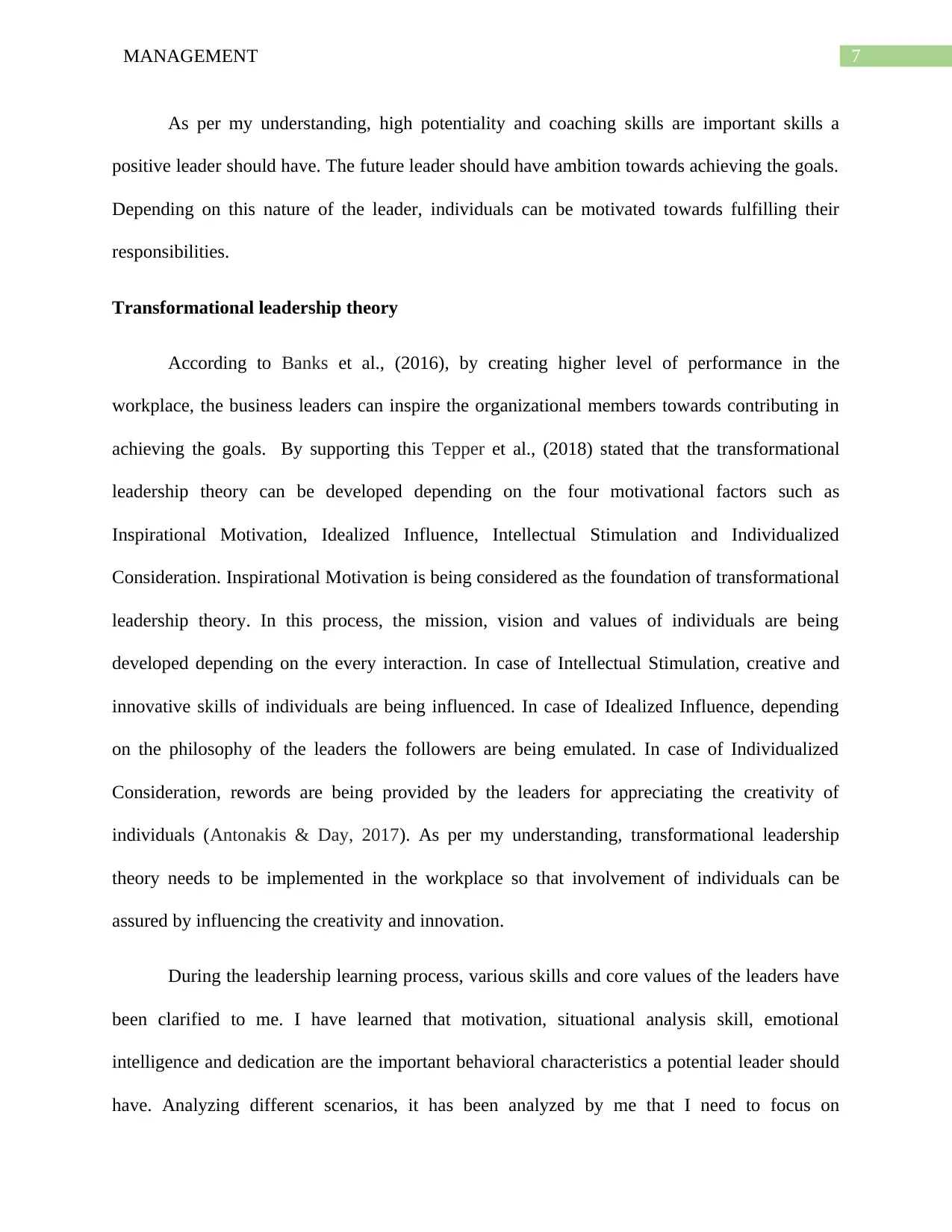
7MANAGEMENT
As per my understanding, high potentiality and coaching skills are important skills a
positive leader should have. The future leader should have ambition towards achieving the goals.
Depending on this nature of the leader, individuals can be motivated towards fulfilling their
responsibilities.
Transformational leadership theory
According to Banks et al., (2016), by creating higher level of performance in the
workplace, the business leaders can inspire the organizational members towards contributing in
achieving the goals. By supporting this Tepper et al., (2018) stated that the transformational
leadership theory can be developed depending on the four motivational factors such as
Inspirational Motivation, Idealized Influence, Intellectual Stimulation and Individualized
Consideration. Inspirational Motivation is being considered as the foundation of transformational
leadership theory. In this process, the mission, vision and values of individuals are being
developed depending on the every interaction. In case of Intellectual Stimulation, creative and
innovative skills of individuals are being influenced. In case of Idealized Influence, depending
on the philosophy of the leaders the followers are being emulated. In case of Individualized
Consideration, rewords are being provided by the leaders for appreciating the creativity of
individuals (Antonakis & Day, 2017). As per my understanding, transformational leadership
theory needs to be implemented in the workplace so that involvement of individuals can be
assured by influencing the creativity and innovation.
During the leadership learning process, various skills and core values of the leaders have
been clarified to me. I have learned that motivation, situational analysis skill, emotional
intelligence and dedication are the important behavioral characteristics a potential leader should
have. Analyzing different scenarios, it has been analyzed by me that I need to focus on
As per my understanding, high potentiality and coaching skills are important skills a
positive leader should have. The future leader should have ambition towards achieving the goals.
Depending on this nature of the leader, individuals can be motivated towards fulfilling their
responsibilities.
Transformational leadership theory
According to Banks et al., (2016), by creating higher level of performance in the
workplace, the business leaders can inspire the organizational members towards contributing in
achieving the goals. By supporting this Tepper et al., (2018) stated that the transformational
leadership theory can be developed depending on the four motivational factors such as
Inspirational Motivation, Idealized Influence, Intellectual Stimulation and Individualized
Consideration. Inspirational Motivation is being considered as the foundation of transformational
leadership theory. In this process, the mission, vision and values of individuals are being
developed depending on the every interaction. In case of Intellectual Stimulation, creative and
innovative skills of individuals are being influenced. In case of Idealized Influence, depending
on the philosophy of the leaders the followers are being emulated. In case of Individualized
Consideration, rewords are being provided by the leaders for appreciating the creativity of
individuals (Antonakis & Day, 2017). As per my understanding, transformational leadership
theory needs to be implemented in the workplace so that involvement of individuals can be
assured by influencing the creativity and innovation.
During the leadership learning process, various skills and core values of the leaders have
been clarified to me. I have learned that motivation, situational analysis skill, emotional
intelligence and dedication are the important behavioral characteristics a potential leader should
have. Analyzing different scenarios, it has been analyzed by me that I need to focus on
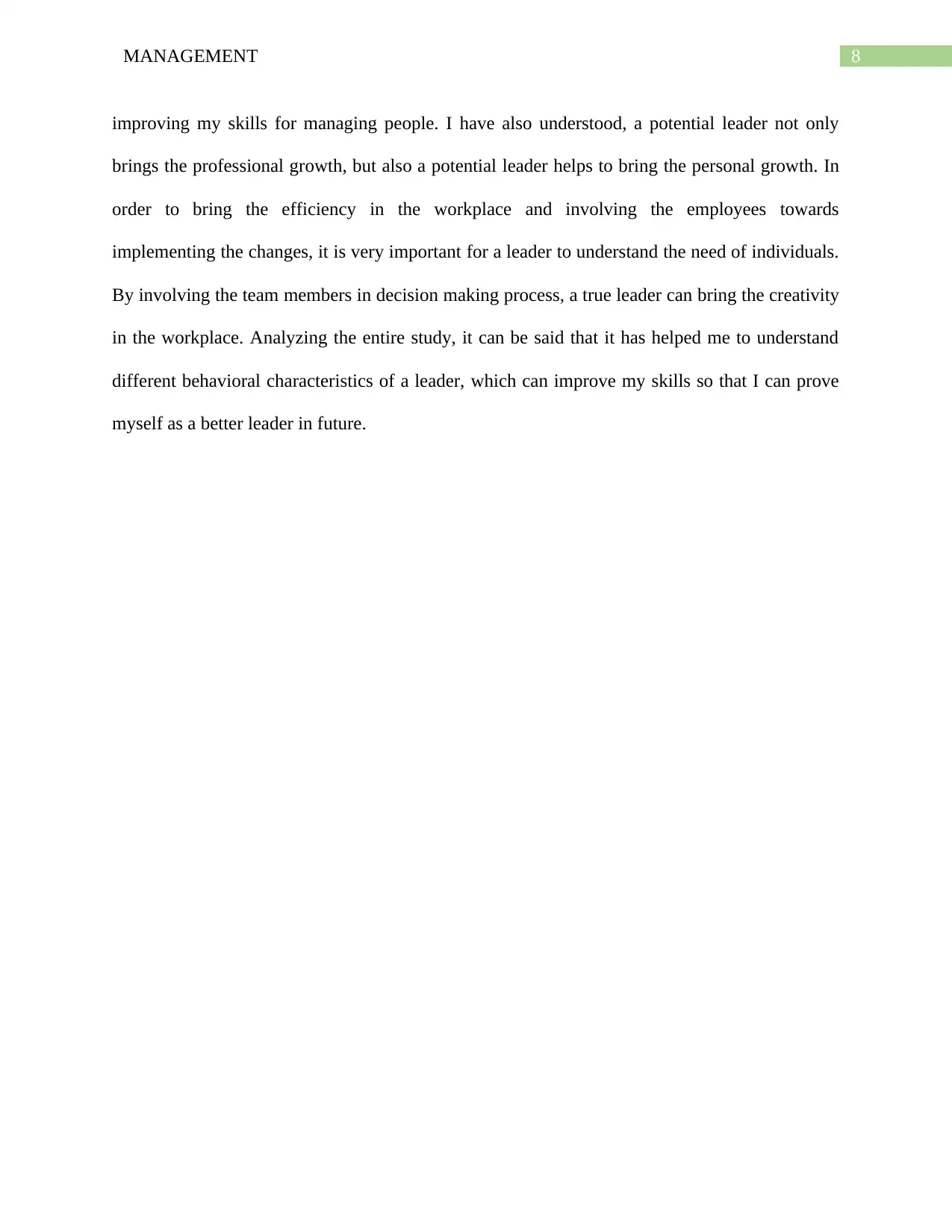
8MANAGEMENT
improving my skills for managing people. I have also understood, a potential leader not only
brings the professional growth, but also a potential leader helps to bring the personal growth. In
order to bring the efficiency in the workplace and involving the employees towards
implementing the changes, it is very important for a leader to understand the need of individuals.
By involving the team members in decision making process, a true leader can bring the creativity
in the workplace. Analyzing the entire study, it can be said that it has helped me to understand
different behavioral characteristics of a leader, which can improve my skills so that I can prove
myself as a better leader in future.
improving my skills for managing people. I have also understood, a potential leader not only
brings the professional growth, but also a potential leader helps to bring the personal growth. In
order to bring the efficiency in the workplace and involving the employees towards
implementing the changes, it is very important for a leader to understand the need of individuals.
By involving the team members in decision making process, a true leader can bring the creativity
in the workplace. Analyzing the entire study, it can be said that it has helped me to understand
different behavioral characteristics of a leader, which can improve my skills so that I can prove
myself as a better leader in future.
⊘ This is a preview!⊘
Do you want full access?
Subscribe today to unlock all pages.

Trusted by 1+ million students worldwide
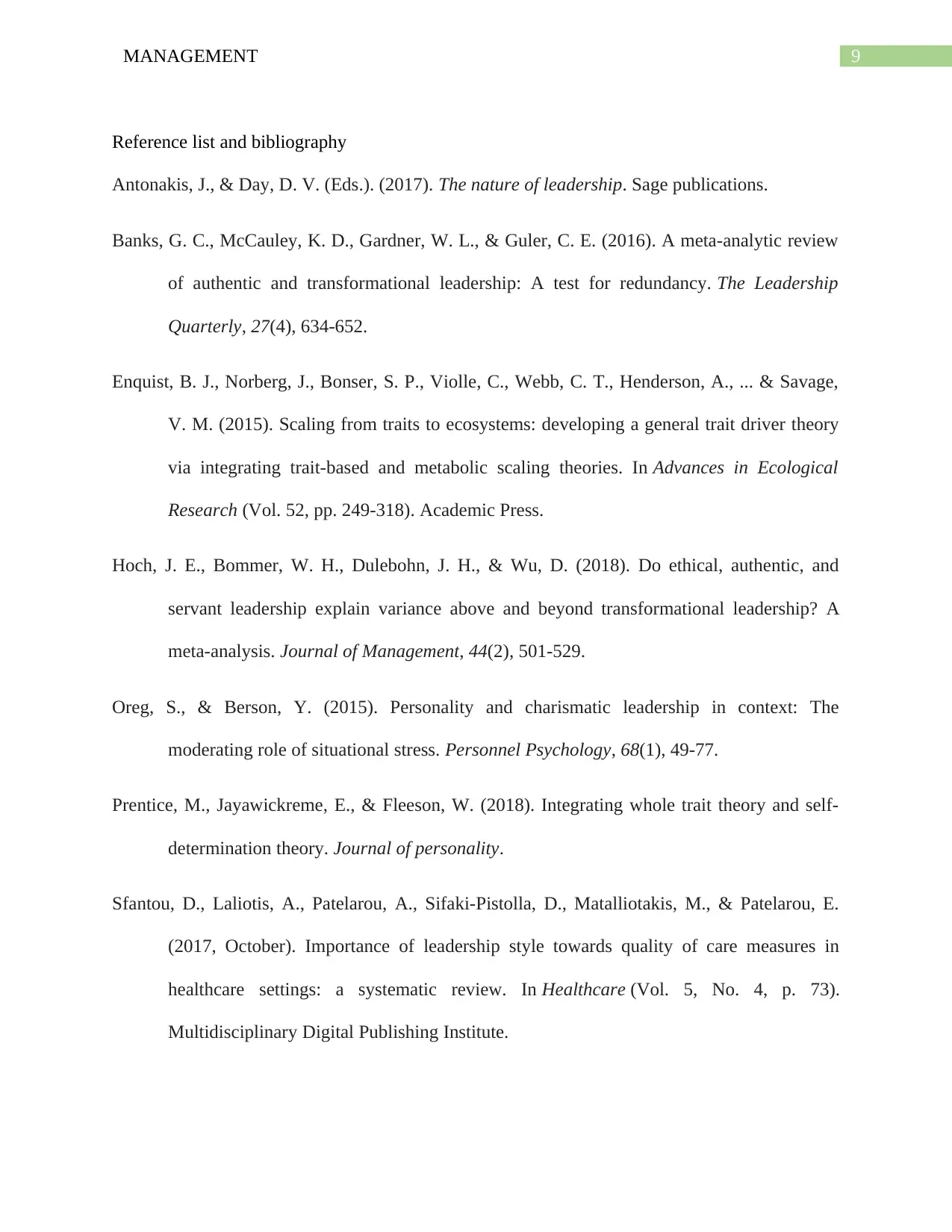
9MANAGEMENT
Reference list and bibliography
Antonakis, J., & Day, D. V. (Eds.). (2017). The nature of leadership. Sage publications.
Banks, G. C., McCauley, K. D., Gardner, W. L., & Guler, C. E. (2016). A meta-analytic review
of authentic and transformational leadership: A test for redundancy. The Leadership
Quarterly, 27(4), 634-652.
Enquist, B. J., Norberg, J., Bonser, S. P., Violle, C., Webb, C. T., Henderson, A., ... & Savage,
V. M. (2015). Scaling from traits to ecosystems: developing a general trait driver theory
via integrating trait-based and metabolic scaling theories. In Advances in Ecological
Research (Vol. 52, pp. 249-318). Academic Press.
Hoch, J. E., Bommer, W. H., Dulebohn, J. H., & Wu, D. (2018). Do ethical, authentic, and
servant leadership explain variance above and beyond transformational leadership? A
meta-analysis. Journal of Management, 44(2), 501-529.
Oreg, S., & Berson, Y. (2015). Personality and charismatic leadership in context: The
moderating role of situational stress. Personnel Psychology, 68(1), 49-77.
Prentice, M., Jayawickreme, E., & Fleeson, W. (2018). Integrating whole trait theory and self‐
determination theory. Journal of personality.
Sfantou, D., Laliotis, A., Patelarou, A., Sifaki-Pistolla, D., Matalliotakis, M., & Patelarou, E.
(2017, October). Importance of leadership style towards quality of care measures in
healthcare settings: a systematic review. In Healthcare (Vol. 5, No. 4, p. 73).
Multidisciplinary Digital Publishing Institute.
Reference list and bibliography
Antonakis, J., & Day, D. V. (Eds.). (2017). The nature of leadership. Sage publications.
Banks, G. C., McCauley, K. D., Gardner, W. L., & Guler, C. E. (2016). A meta-analytic review
of authentic and transformational leadership: A test for redundancy. The Leadership
Quarterly, 27(4), 634-652.
Enquist, B. J., Norberg, J., Bonser, S. P., Violle, C., Webb, C. T., Henderson, A., ... & Savage,
V. M. (2015). Scaling from traits to ecosystems: developing a general trait driver theory
via integrating trait-based and metabolic scaling theories. In Advances in Ecological
Research (Vol. 52, pp. 249-318). Academic Press.
Hoch, J. E., Bommer, W. H., Dulebohn, J. H., & Wu, D. (2018). Do ethical, authentic, and
servant leadership explain variance above and beyond transformational leadership? A
meta-analysis. Journal of Management, 44(2), 501-529.
Oreg, S., & Berson, Y. (2015). Personality and charismatic leadership in context: The
moderating role of situational stress. Personnel Psychology, 68(1), 49-77.
Prentice, M., Jayawickreme, E., & Fleeson, W. (2018). Integrating whole trait theory and self‐
determination theory. Journal of personality.
Sfantou, D., Laliotis, A., Patelarou, A., Sifaki-Pistolla, D., Matalliotakis, M., & Patelarou, E.
(2017, October). Importance of leadership style towards quality of care measures in
healthcare settings: a systematic review. In Healthcare (Vol. 5, No. 4, p. 73).
Multidisciplinary Digital Publishing Institute.
Paraphrase This Document
Need a fresh take? Get an instant paraphrase of this document with our AI Paraphraser
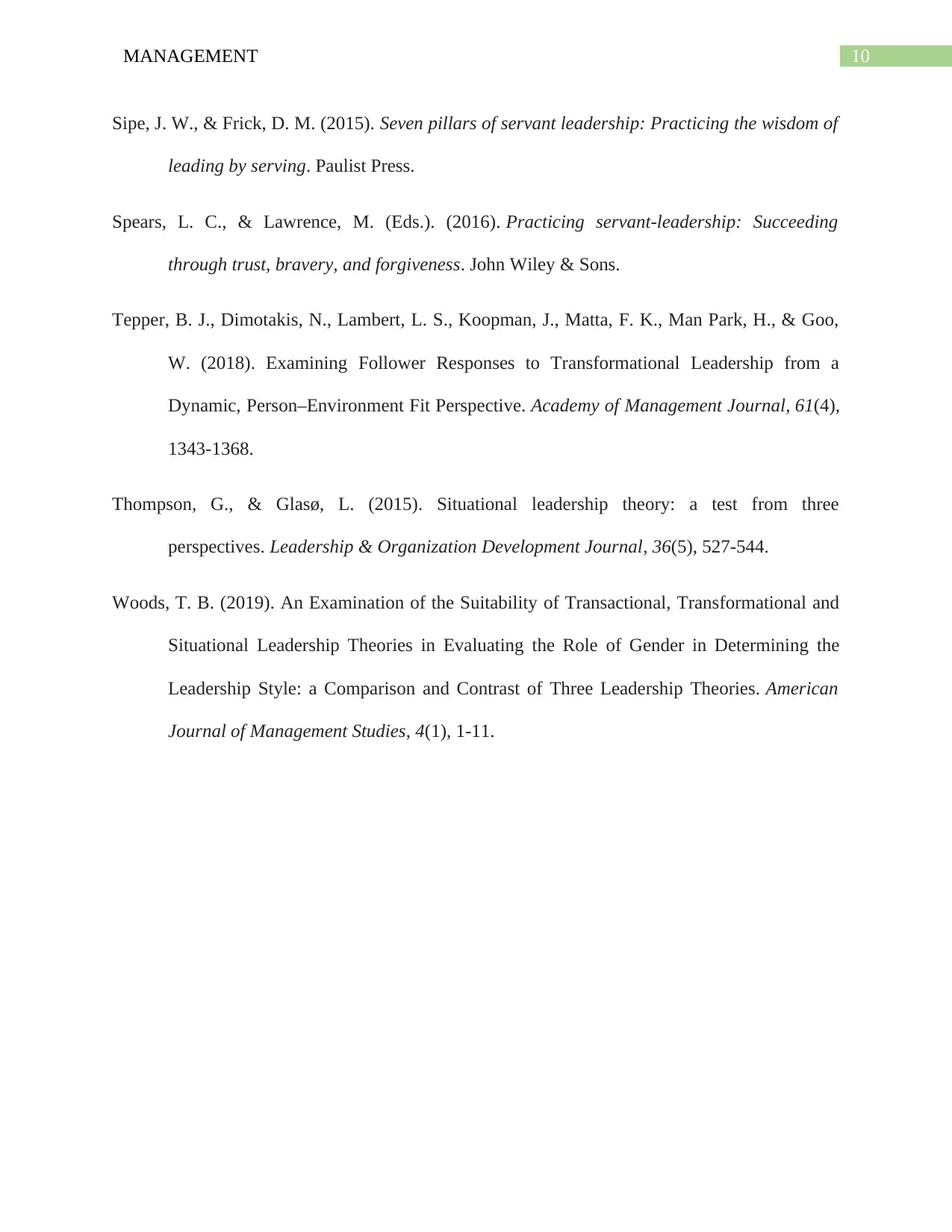
10MANAGEMENT
Sipe, J. W., & Frick, D. M. (2015). Seven pillars of servant leadership: Practicing the wisdom of
leading by serving. Paulist Press.
Spears, L. C., & Lawrence, M. (Eds.). (2016). Practicing servant-leadership: Succeeding
through trust, bravery, and forgiveness. John Wiley & Sons.
Tepper, B. J., Dimotakis, N., Lambert, L. S., Koopman, J., Matta, F. K., Man Park, H., & Goo,
W. (2018). Examining Follower Responses to Transformational Leadership from a
Dynamic, Person–Environment Fit Perspective. Academy of Management Journal, 61(4),
1343-1368.
Thompson, G., & Glasø, L. (2015). Situational leadership theory: a test from three
perspectives. Leadership & Organization Development Journal, 36(5), 527-544.
Woods, T. B. (2019). An Examination of the Suitability of Transactional, Transformational and
Situational Leadership Theories in Evaluating the Role of Gender in Determining the
Leadership Style: a Comparison and Contrast of Three Leadership Theories. American
Journal of Management Studies, 4(1), 1-11.
Sipe, J. W., & Frick, D. M. (2015). Seven pillars of servant leadership: Practicing the wisdom of
leading by serving. Paulist Press.
Spears, L. C., & Lawrence, M. (Eds.). (2016). Practicing servant-leadership: Succeeding
through trust, bravery, and forgiveness. John Wiley & Sons.
Tepper, B. J., Dimotakis, N., Lambert, L. S., Koopman, J., Matta, F. K., Man Park, H., & Goo,
W. (2018). Examining Follower Responses to Transformational Leadership from a
Dynamic, Person–Environment Fit Perspective. Academy of Management Journal, 61(4),
1343-1368.
Thompson, G., & Glasø, L. (2015). Situational leadership theory: a test from three
perspectives. Leadership & Organization Development Journal, 36(5), 527-544.
Woods, T. B. (2019). An Examination of the Suitability of Transactional, Transformational and
Situational Leadership Theories in Evaluating the Role of Gender in Determining the
Leadership Style: a Comparison and Contrast of Three Leadership Theories. American
Journal of Management Studies, 4(1), 1-11.
1 out of 11
Related Documents
Your All-in-One AI-Powered Toolkit for Academic Success.
+13062052269
info@desklib.com
Available 24*7 on WhatsApp / Email
![[object Object]](/_next/static/media/star-bottom.7253800d.svg)
Unlock your academic potential
Copyright © 2020–2025 A2Z Services. All Rights Reserved. Developed and managed by ZUCOL.




